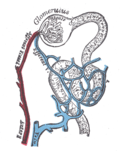Afferent arterioles
Blood vessels that supply blood to the nephrons of the kidney
Afferent arterioles are small blood vessels that play a crucial role in the renal system by supplying blood to the glomerulus of each nephron in the kidney. These arterioles are key components in the regulation of blood pressure and filtration rate within the kidneys.
Structure[edit]
The afferent arterioles branch from the interlobular arteries and lead into the glomerular capillaries. They are characterized by a relatively thick muscular wall, which allows them to regulate blood flow into the glomerulus. The diameter of the afferent arterioles can be adjusted to control the glomerular filtration rate (GFR).
Function[edit]
The primary function of the afferent arterioles is to deliver blood to the glomeruli, where filtration occurs. The arterioles play a significant role in the autoregulation of renal blood flow and GFR. They respond to various physiological signals, such as changes in blood pressure and sympathetic nervous system activity, to maintain stable kidney function.
Regulation[edit]
Afferent arterioles are involved in the myogenic mechanism and tubuloglomerular feedback, which are essential for the autoregulation of renal blood flow. The myogenic mechanism involves the contraction and relaxation of the smooth muscle in response to changes in blood pressure. Tubuloglomerular feedback involves the juxtaglomerular apparatus, which senses changes in the flow of sodium chloride in the distal convoluted tubule and adjusts the diameter of the afferent arterioles accordingly.
Clinical significance[edit]
Dysfunction of the afferent arterioles can lead to various renal pathologies. For example, constriction of these arterioles can reduce blood flow to the glomeruli, leading to decreased GFR and potential acute kidney injury. Conversely, excessive dilation can increase glomerular pressure, potentially causing glomerular damage and contributing to conditions such as hypertension and chronic kidney disease.
Related pages[edit]
Gallery[edit]
-
Diagram of kidney showing the afferent arterioles.
-
Detailed view of the renal corpuscle.
-
Histological section of a renal corpuscle.
-
Illustration of glomerular physiology.
-
Diagram of a renal corpuscle.
Afferent arterioles[edit]
-
Afferent arterioles diagram
-
Afferent arterioles and glomerulus
-
Malpighian corpuscle
-
Glomerular physiology
-
Renal corpuscle
Ad. Transform your life with W8MD's Budget GLP-1 injections from $75


W8MD offers a medical weight loss program to lose weight in Philadelphia. Our physician-supervised medical weight loss provides:
- Weight loss injections in NYC (generic and brand names):
- Zepbound / Mounjaro, Wegovy / Ozempic, Saxenda
- Most insurances accepted or discounted self-pay rates. We will obtain insurance prior authorizations if needed.
- Generic GLP1 weight loss injections from $75 for the starting dose.
- Also offer prescription weight loss medications including Phentermine, Qsymia, Diethylpropion, Contrave etc.
NYC weight loss doctor appointmentsNYC weight loss doctor appointments
Start your NYC weight loss journey today at our NYC medical weight loss and Philadelphia medical weight loss clinics.
- Call 718-946-5500 to lose weight in NYC or for medical weight loss in Philadelphia 215-676-2334.
- Tags:NYC medical weight loss, Philadelphia lose weight Zepbound NYC, Budget GLP1 weight loss injections, Wegovy Philadelphia, Wegovy NYC, Philadelphia medical weight loss, Brookly weight loss and Wegovy NYC
|
WikiMD's Wellness Encyclopedia |
| Let Food Be Thy Medicine Medicine Thy Food - Hippocrates |
Medical Disclaimer: WikiMD is not a substitute for professional medical advice. The information on WikiMD is provided as an information resource only, may be incorrect, outdated or misleading, and is not to be used or relied on for any diagnostic or treatment purposes. Please consult your health care provider before making any healthcare decisions or for guidance about a specific medical condition. WikiMD expressly disclaims responsibility, and shall have no liability, for any damages, loss, injury, or liability whatsoever suffered as a result of your reliance on the information contained in this site. By visiting this site you agree to the foregoing terms and conditions, which may from time to time be changed or supplemented by WikiMD. If you do not agree to the foregoing terms and conditions, you should not enter or use this site. See full disclaimer.
Credits:Most images are courtesy of Wikimedia commons, and templates, categories Wikipedia, licensed under CC BY SA or similar.
Translate this page: - East Asian
中文,
日本,
한국어,
South Asian
हिन्दी,
தமிழ்,
తెలుగు,
Urdu,
ಕನ್ನಡ,
Southeast Asian
Indonesian,
Vietnamese,
Thai,
မြန်မာဘာသာ,
বাংলা
European
español,
Deutsch,
français,
Greek,
português do Brasil,
polski,
română,
русский,
Nederlands,
norsk,
svenska,
suomi,
Italian
Middle Eastern & African
عربى,
Turkish,
Persian,
Hebrew,
Afrikaans,
isiZulu,
Kiswahili,
Other
Bulgarian,
Hungarian,
Czech,
Swedish,
മലയാളം,
मराठी,
ਪੰਜਾਬੀ,
ગુજરાતી,
Portuguese,
Ukrainian




